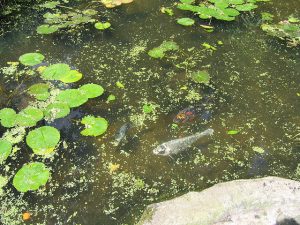In the mid-70s, John Travolta starred in a movie called the Boy in the Plastic Bubble. It centered around a young man that had an inadequate immune system that was shut off from the world in a plastic dome as a precaution. So what does this have to do with koi?
Old Pond Syndrome
There is a comparable phenomenon in the world of koi keeping, too. You may have heard about New Pond Syndrome, but you may not have heard about what some koi enthusiasts have dubbed Old Pond Syndrome (OPS).
OPS is essentially new pond syndrome in reverse. It is a pond that has been “over-cycled” to the point where the addition of any foreign entity can tip the fragile balance in a controlled—but flawed—system.
There are scenarios wherein koi keepers have a pond, and they have fish in the pond that have been there for years and years. For whatever reason they haven’t added any new fish over the course of the pond aging. They then finally find and introduce what they think will be a nice addition, and all the existing fish immediately crash and die, while all the new fish live happily ever after.
The immediate assumption would naturally be that the new koi must have brought disease or illness to the party with them. However, this still happens after a new koi has undergone a quarantine period, too.
“Bubble Koi”

One hypothesis is that the “Bubble Koi” happens as a result of an environment that hasn’t undergone any significant shifts in parameters or stressors for so long that it results in the existing fish living on this razor thin precipice of homeostasis.
Like the Boy in the Bubble, the introduction of anything new to his static environment was what would interrupt the balance in his unprepared immune system. Similarly, it is the exposure of the “outside world,” when the new fish are introduced, that stress alone can kill the existing koi almost immediately.
It’s the state of the Bubble Koi in the old pond that makes it so weak to the point where any parasite or bacteria can kill it very quickly. So whereas healthy and strong koi might not get sick, or might get sick but have enough vigor for the hobbyist to diagnose and treat the problem, the OPS Bubble Koi are not.
With no challenges, the koi’s immune system is not prepared to handle the inclusion of newer fish, so essentially something as simple as a “sniffle” is enough to be catastrophic.
Basically, the theory that is emerging is that they’re just barely healthy enough to survive in this undisturbed pond, but when new fish get added, everything gets turned on it’s head and all the old fish lack the capacity or immunity to handle the change.
And it is not just enthusiasts that have noted this phenomenon, it is koi suppliers too. This article on the Sacramento Koi website explores how fragile koi can be coming from an established pond where the koi have become accustomed to the status quo.
Much of this is still speculation, and there isn’t much scientific evidence to back it up, but there is enough anecdotal evidence that suggests that Old Pond Syndrome could actually be the cause of the Bubble Koi.
Bio Security
Next Day Koi is committed to keeping any and all koi we supply as health issue free as absolutely possible. Every fish sent from our suppliers are quarantined in separate holding facilities for a minimum of two weeks. Additionally, one of our suppliers is certified as “bio secure”, to ensure the highest standards of quality and good health possible.
We’d love you to share any experiences you might have had or even any thoughts you have on this in the comments section, or shoot us an email at sales@nextdaykoi.com.


One of my koi fish has died .. ( one of 4.., in a 150 gal. Stock tank),! Noticed bubbles on the surface of the tank..?HELP!